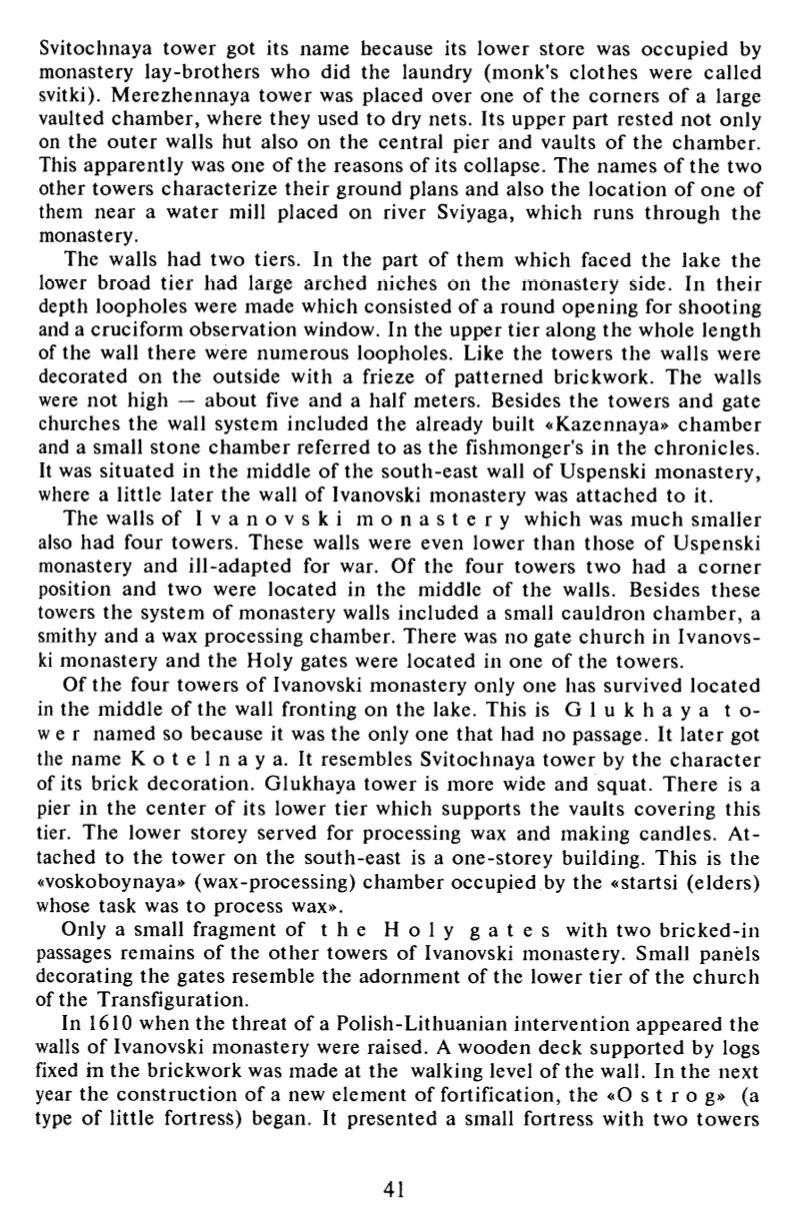

Svitochnaya tower got its name because its lower store was occup ied by
monastery lay-brothers who did the laundry (monk's clothes were called
svitki). Merezhennaya tower was placed over one o f the corners o f a large
vaulted chamber, where they used to dry nets. Its upper part rested no t only
on the ou ter walls hut also on the central pier and vaults o f the chamber.
This apparently was one o f the reasons of its collapse. The names o f the two
other towers characterize their ground plans and also the location o f one of
them near a water mill placed on river Sviyaga, which runs th rough the
monastery.
The walls had two tiers. In the part of them which faced the lake the
lower broad tier had large arched niches on the monastery side. In their
depth loopholes were made which consisted o f a round opening for shooting
and a cruciform observation window. In the upper tier along the whole length
of the wall there were numerous loopholes. Like the towers the walls were
decorated on the outside with a frieze of patterned brickwork. The walls
were not high — about five and a half meters. Besides the towers and gate
churches the wall system included the already built «Kazennaya» chambe r
and a small stone chamber referred to as the fishmonger's in the chronicles.
It was situated in the middle o f the south-east wall o f Uspenski monastery,
where a little later the wall of Ivanovski monastery was attached to it.
The walls o f I v a n o v s k i m o n a s t e r y which was much smaller
also had four towers. These walls were even lower than those o f Uspenski
monastery and ill-adapted for war. Of the four towers two had a co rne r
position and two were located in the middle of the walls. Besides these
towers the system o f monastery walls included a small cauldron chambe r, a
smithy and a wax processing chamber. There was no gate chu rch in Ivanovs
ki monastery and the Holy gates were located in one o f the towers.
Of the four towers o f Ivanovski monastery only one has survived located
in the middle o f the wall fronting on the lake. This is G l u k h a y a t o
w e r named so because it was the only one that had no passage. It later got
the name K o t e l n a y a . It resembles Svitochnaya tower by the cha rac te r
of its brick decoration. Glukhaya tower is more wide and squat. There is a
pier in the cen te r o f its lower tier which supports the vaults covering this
tier. The lower storey served for processing wax and making candles. A t
tached to the tower on the south-east is a one-storey building. This is the
«voskoboynaya» (wax-processing) chamber occupied by the «startsi (elders)
whose task was to process wax».
Only a small fragment of t h e H o l y g a t e s with two b ricked-in
passages remains o f the o ther towers of Ivanovski monastery. Small panels
decorating the gates resemble the adornment of the lower tier o f the chu rch
of the Transfiguration.
In 1610 when the threat of a Polish-Lithuanian intervention appeared the
walls of Ivanovski monastery were raised. A wooden deck supported by logs
fixed m the brickwork was made at the walking level of the wall. In the next
year the construc tion of a new element of fortification, the «О s t г о g» (a
type o f little fortress) began. It presented a small fortress with two towers
41















